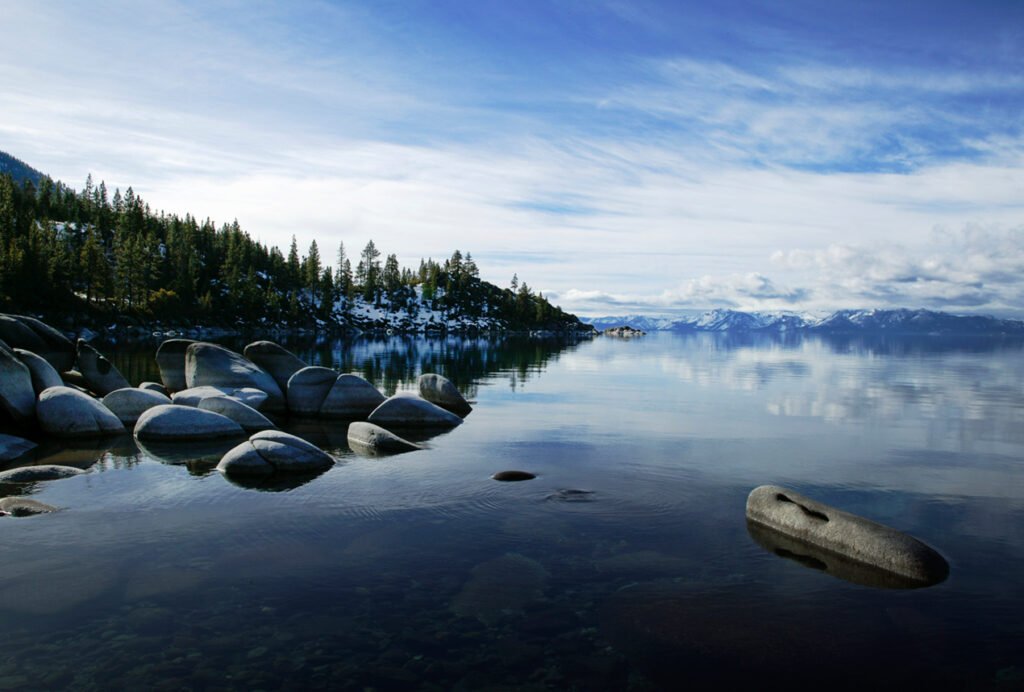Changing winters are impacting Lake Tahoe and other freshwater ecosystems
Recent research sheds light on how freshwaters are threatened by climate change and impacts to winter
RENO, Nev. – As temperatures rise, particularly in alpine regions, lakes are feeling the heat. Research published today in the journal Science, led by researchers at the Carnegie Institution for Science, indicates that climate change impacts critical winter processes including lake ice conditions. Changes in lake ice conditions impact the function of ecosystems and the communities that live nearby. With climate affecting this critical winter process one can ask, what other critical changes to freshwaters might occur from changing winters whether at Lake Tahoe, or the small lakes and streams in the mountains of California and Nevada?
Sudeep Chandra, a professor at the University of Nevada, Reno, was part of the study and has been studying lake ecosystems for over two decades.
“Winter change from a human-altered climate is an important area of focus for scientists and policy makers,” Chandra said. “We need to learn more about how this change in winter, whether from snowpack dropping on to a watershed or the loss of lake or stream-ice, may have lasting ramifications for what we might observe in the ice-free summer season.”
There are many ways climate change can and will impact western alpine lakes.
Changing snowpack and winter conditions can extend plant growing seasons for lakes in the summer, increasing the opportunities for invasive species to take hold within a lake or expand their range.
Lake Tahoe’s cold water-preferring native species are maladapted to warm water. Physiological threats to native species, compounded by competition and predation from invasive species like bass and bluegill which are better adapted to warm temperatures, can have serious repercussions for the native flora and fauna in Lake Tahoe.
Beyond changing the balance of invasive to native species in lakes, changing winters can affect the important hydrologic and water quality connections, from the groundwater and streams to lakes. Maintaining these connections are critical not only for the living things that might need the connections to live out their life cycles but also for supplying nutrients to the edge of the lakes at the right time to promote healthy conditions at the edge of a lake.
Warming temperatures are associated with increased susceptibility to harmful algal and cyanobacterial blooms, which can limit recreational use and the water quality of both streams and lakes. For regions which rely heavily on recreation, like Lake Tahoe, algal blooms can mean decreased tourism, negatively impacting the economy.
As winters change with variable and less snowpack and warm temperatures occur, snowpack melting happens earlier in the year. In Lake Tahoe and elsewhere in the mountains of California, runoff occurs in late May into June. A climate assessment for Lake Tahoe facilitated by the agencies suggest that run off will shift to January toward the end of century.
The timing of flow provides important cues for native fish for spawning, and if fish lay their eggs too early, it can have disastrous effects on native fish populations. The timing and amount of peak snowmelt also affects the growth of algae that supports nearshore food webs and the clarity of the water at the stream-to-lake interface, according to Joanna Blaszczak, an assistant professor at the University of Nevada, Reno.
“While Lake Tahoe does not typically have ice in the winter, the smaller lakes and streams in the Tahoe basin and across the mountains of California rely on ice conditions as an important variable which drives the ecology in the ice free, summer season,” Chandra said. “For people like me who love to fish or swim on clear and clean shorelines, the change in winter ice condition will impact my summer experiences.”
Ice breakup is a positive feedback process determined by the winter to spring conditions of snowpack and temperature. As winter changes with climate change, ice conditions will also change in the mountains of the western US. Chandra and other researchers from the University of Nevada, Reno’s Global Water Center found that small mountain lakes are more vulnerable to ice breakup with a changing climate. Their research indicates that by the end of the century, ice break up in mountain lakes could be as early as 25 to 61 days earlier than present day.
Smaller lakes in the mountains and the animals and plants that live in them rely on winter and ice. In another study from Castle Lake, a long-term ecological research site in California, Chandra and colleagues found that when ice on the lake melted sooner, the occupation of different lake habitats (nearshore versus deep water) changed for Brook Trout, as did their feeding behaviors. Despite having more food available in nearshore habitats, the fish avoided it because the water was too warm, resulting in smaller, less healthy fish.
“The science that is needed to conserve Lake Tahoe or the smaller streams and lakes in the Tahoe basin or California need to account for changes to winter processes,” Chandra said.
“Investments that can integrate our scientific understanding of winter into the future condition of freshwater quality and ecosystem function are needed, as we plan for the future under these changing conditions,” Blaszczak said.
In the Science article, the researchers emphasize that more wintertime research should be done to better understand lake ecology and risks posed by increased warming.
“Over a billion people live near lakes that freeze, and these changes are now affecting people’s uses of lakes,” Stephanie Hampton, the lead author of the paper from Carnegie Science said. “By analyzing what we know about how these changes are affecting lake ecosystems and human communities, we have identified key topics that must be studied in greater detail. It is only by understanding the breadth and complexity of these risks that we can develop strategies for mitigating them.”
Photo: Lake Tahoe winters are a crucial part of the ecosystem and the economy, but face disturbances with climate change.







More Stories
December 4, 2025: Lyon Board of County Commissioners to Address Monarch Data Center Request for Mason Valley Rezoning
NOTICE OF PROPOSED ACTION – Bureau of Water Pollution Control: PERI & SONS FARMS LABOR HOUSING
December Skies Over Mason Valley: A Month of Celestial Wonder